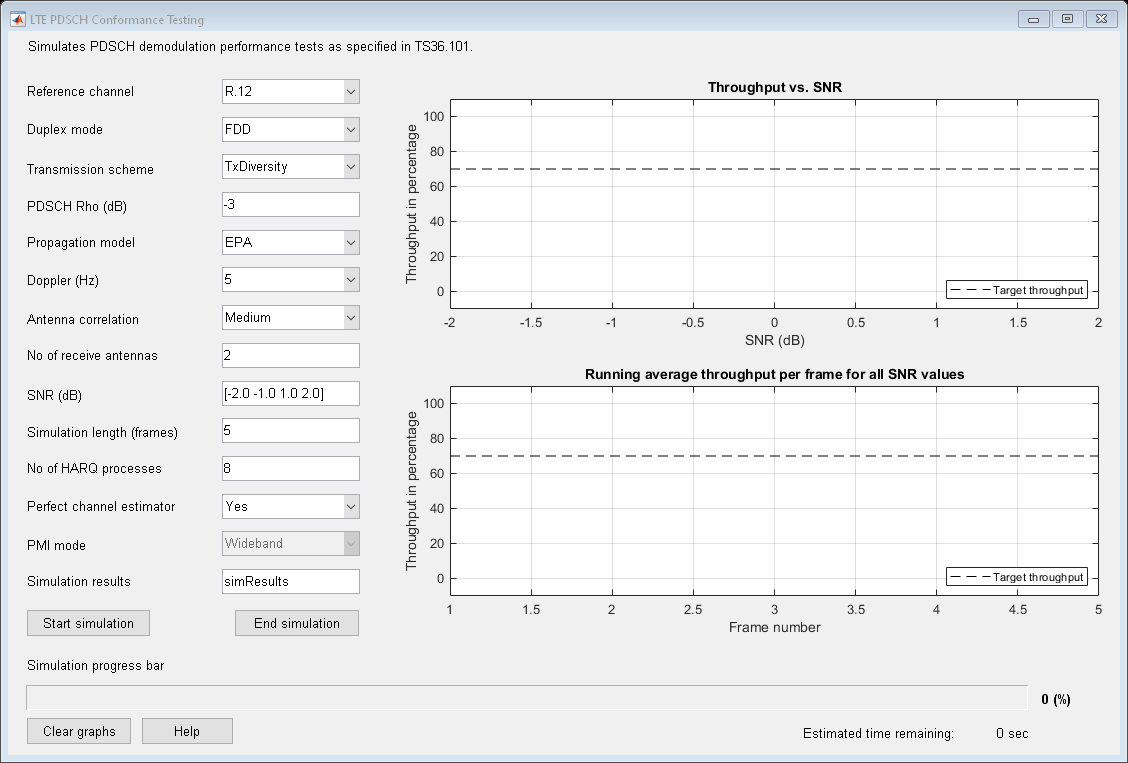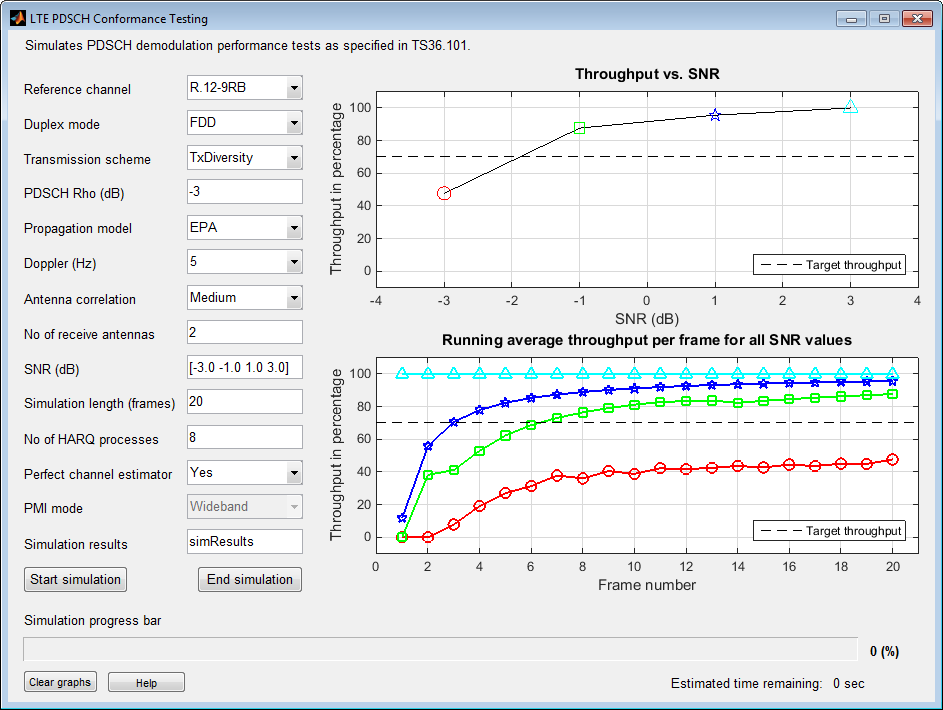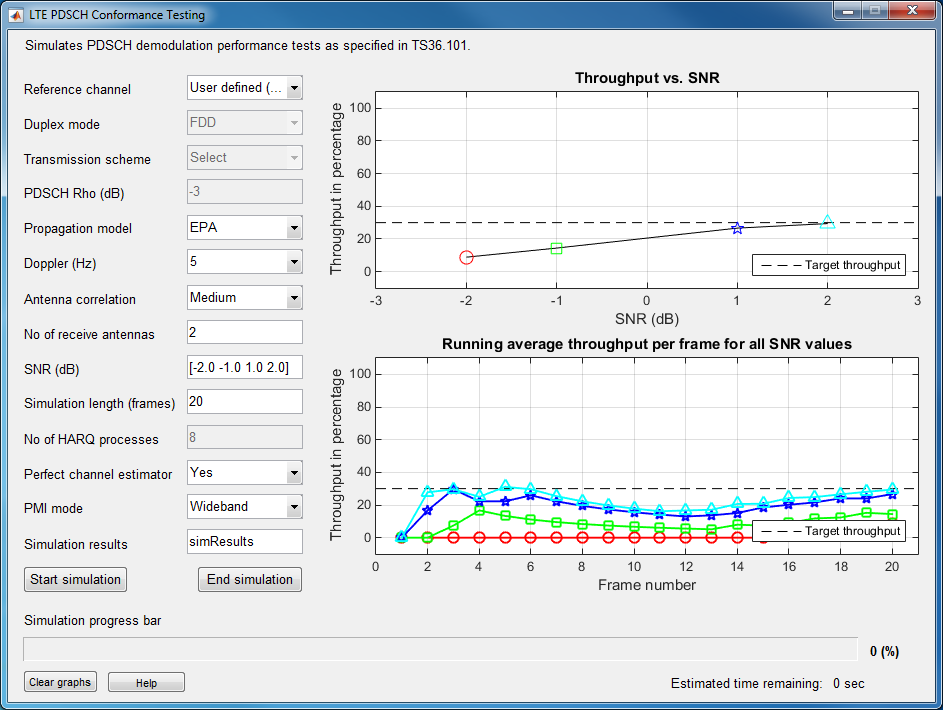Analyze Throughput for PDSCH Demodulation Performance Test
LTE Throughput Analyzer Overview
You can use the LTE Throughput Analyzer app to execute a physical downlink shared channel (PDSCH) demodulation performance test.
Open LTE Throughput Analyzer App
To open the LTE Throughput Analyzer app, select the APPS tab on the MATLAB desktop and click the following icon.
![]()
Alternatively, you can open the LTE Throughput Analyzer app from the MATLAB® command window.
Open LTE Throughput Analyzer App from Command Line
The LTE Throughput Analyzer dialog box appears when you execute the lteDLConformanceTestTool function with no input arguments.
lteDLConformanceTestTool
Warning: BorderType will not accept beveledin in a future release. Use "line" or "none" instead.

Dialog Box Inputs and Outputs
Parameters
In the LTE PDSCH Conformance Testing user interface, you can set these parameters:
| Parameter (Equivalent Field) | Values | Description | ||||||||||||||||||||
|---|---|---|---|---|---|---|---|---|---|---|---|---|---|---|---|---|---|---|---|---|---|---|
Reference channel (RC) |
| Reference measurement channel (RMC) number or type, as specified in TS 36.101, Annex A.3.
To define your own reference channel, select
The tool expects this variable to be
present in the MATLAB base workspace. Create the basic configuration structure with
the function | ||||||||||||||||||||
Duplex mode (DuplexMode) |
| Duplexing mode, specified as either:
| ||||||||||||||||||||
Transmission scheme (TxScheme) |
| PDSCH transmission scheme, specified as one of the following options.
| ||||||||||||||||||||
PDSCH Rho (dB) (Rho) | 0 (default), numeric scalar | PDSCH resource element power allocation, in dB | ||||||||||||||||||||
Propagation Model (DelayProfile) |
| Delay profile model. For more information, see Propagation Channel Models. | ||||||||||||||||||||
Doppler (Hz) (DopplerFreq) |
| Maximum Doppler frequency, in Hz. | ||||||||||||||||||||
Antenna Correlation (MIMOCorrelation) |
| Correlation between UE and eNodeB antennas | ||||||||||||||||||||
No of receive antennas (NRxAnts) | Nonnegative scalar integer | Number of receive antennas | ||||||||||||||||||||
| SNR (dB) | Numeric vector | SNR values, in dB | ||||||||||||||||||||
| Simulation length (frames) | Positive scalar integer | Simulation length, in frames | ||||||||||||||||||||
Number of HARQ processes (NHARQProcesses) | 1, 2, 3, 4, 5, 6, 7, or 8 | Number of HARQ processes per component carrier | ||||||||||||||||||||
| Perfect channel estimator |
| Channel estimator provides a perfect channel estimate
when setting is | ||||||||||||||||||||
PMI mode (PMIMode) |
| PMI reporting mode. | ||||||||||||||||||||
| Simulation results | Variable name beginning with an alphabetical character and containing alphanumeric characters. | Simulation results output variable name. When you click Generate waveform, a new variable with this name is created in the MATLAB workspace. |
Examples
Perform 4-by-2 Transmit Diversity Conformance Test
This example shows how to run a conformance test for a single codeword RMC R.12-9RB for the transmit diversity transmission scheme with EPA-5 fading.
Open the LTE Throughput Analyzer app. Select the APPS tab on the MATLAB desktop and click the following icon.
![]()
The LTE PDSCH Conformance Testing dialog box opens.
From the Reference channel drop-down list, choose
R.12-9RB.
For SNR, enter [-3.0 -1.0 1.0
3.0].
For Simulation length (frames), enter
20.
Click the Start simulation button. Wait a few minutes for the simulation to run. In the bottom-right corner of the window, next to Estimated time remaining, the tool displays an approximation of how long the simulation still needs to run. When the simulation finishes, the dialog box appears as shown in the following figure.

The simulation result for a 20-frame run is displayed in the MATLAB Command Window.
Result for -3 dB SNR Throughput: 47.65% Result for -1 dB SNR Throughput: 87.65% Result for 1 dB SNR Throughput: 95.59% Result for 3 dB SNR Throughput: 100.00%
In addition, the simResults variable now appears in
the MATLAB workspace. Enter simResults to see its
contents.
simResults
simResults =
1x4 struct array with fields:
throughput
tpPerFrame
rawBERPerform Customized Conformance Test with User-Defined Configuration
This example shows how to run a conformance test for a user-defined configuration structure. You can carry out performance analysis and testing under user-defined settings. To do so, select 'User defined' from the “Reference channel” popup menu, which will then prompt for the configuration structure variable name. The test bench will expect this variable to be present (already defined by the user) in the 'base' workspace.
Perform the single physical resource block (PRB) RMC R.0 conformance
test, except with the allocated resource block moved to the upper band
edge rather than lower band edge. First, create the basic configuration
structure with the function lteRMCDL. Choose the
most closely-matched RMC. Then, modify it with this the
PRBSet requirement.
rmc = lteRMCDL('R.0');
rmc.PDSCH.PRBSet = rmc.NDLRB-1;
Open the LTE Throughput Analyzer app. Select the APPS tab on the MATLAB desktop and click the following icon.
![]()
The LTE PDSCH Conformance Testing dialog box opens.
From the Reference channel drop-down list, choose
User defined. The User Defined
Configuration dialog box opens.
For Configuration structure variable name, enter
rmc. Click OK.
Click the Start simulation button. Wait a few minutes for the simulation to run. In the bottom-right corner of the window, next to Estimated time remaining, the tool displays an approximation of how long the simulation still needs to run. When the simulation finishes, the dialog box appears as shown in the following figure.

The simulation result for a 20-frame run is displayed in the MATLAB Command Window.
Result for -2 dB SNR Throughput: 7.22% Result for -1 dB SNR Throughput: 15.56% Result for 1 dB SNR Throughput: 28.33% Result for 2 dB SNR Throughput: 33.89%
In addition, the simResults variable now appears in
the MATLAB workspace. Enter simResults to see its
contents.
simResults
simResults =
1x4 struct array with fields:
throughput
tpPerFrame
rawBERReferences
[1] 3GPP TS 36.101. “Evolved Universal Terrestrial Radio Access (E-UTRA); User Equipment (UE) Radio Transmission and Reception.” 3rd Generation Partnership Project; Technical Specification Group Radio Access Network. URL: https://www.3gpp.org.